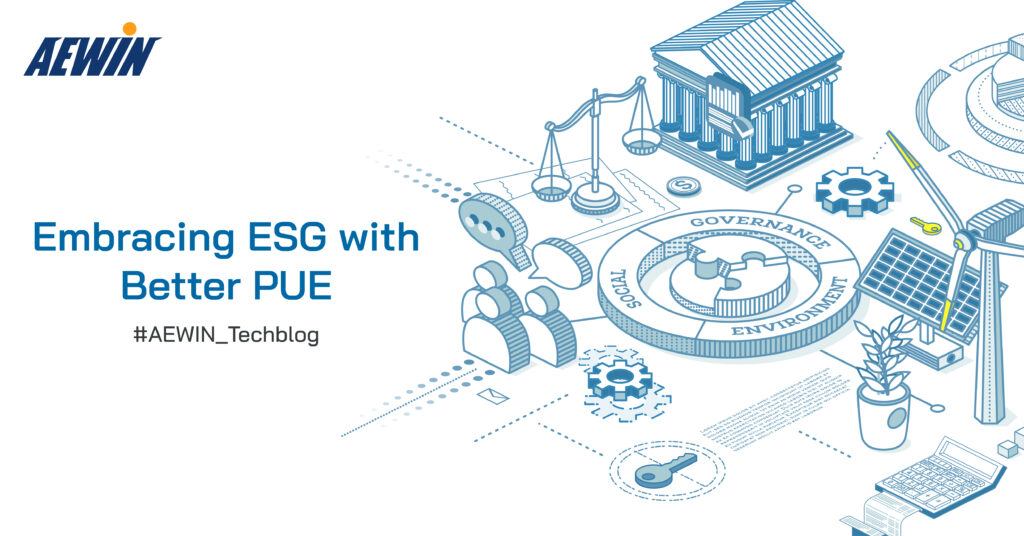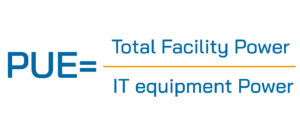
Background
As the awareness of sustainable development rises, enterprises are pursuing greener infrastructures and solutions. Net zero would be the ultimate goal in the near future. IT devices is one of the top sources of carbon emission and the emissions momentum is still increasing due to the global demands of higher performance, better data storage, and faster communications.
To obtain the win-win of both “environmental protection” and “economics”, ESG has become an enterprise development trend to maintain a leading position in this international competition. ESG stands for Environment, Social, and Governance, and is a set of criteria how a company operates regarding the planet and its people. Investors are paying more and more attention to ESG indicators, and enterprises have been involved ESG in corporate strategic planning and setup relevant policies.
To achieve sustainable development, one of the KPI of ESG is PUE. The first step in improving the energy efficiency of the data center is to assess the efficiency of the electricity usage. Let us take a closer look at this.
Embracing ESG with Better PUE
What is PUE (Power Usage Effectiveness)?
Power usage effectiveness (PUE) is an indicator that refers to how efficiently a data center uses energy. PUE is a ratio defined as the power used by total facility divided by the power used to run its IT equipment as illustrated below.

The value is greater than 1. The closer it is to 1, the less energy consumed by non-IT equipment which represents the better energy efficiency level.
Reach the Ideal PUE to embrace ESG
The ideal PUE is 1. To approach to the target, energy-saving and environmental protection shall be considered in the design and planning of the computer room in the early stage of construction. Enterprises can routinely measure PUE and take advantage of intelligent management system with dashboard to accomplish real-time monitoring to identify, analyze, and correct IT inefficiencies to reduce carbon footprint emissions. Our previous Tech Blog of “Sustainable Intelligent Manufacturing” also mentioned how AI enable the greener manufacturing by enhancing efficiency, reducing waste, and having improved energy management. In addition, liquid economizer systems consisting of in-rack CDU (Cooling Distribution Units) and cooling water towers help to improve the efficiency of air conditioning equipment in the data center.
Another approach to achieve better PUE is to optimize individual servers. Implementing up-to-date servers with enhanced power design, better thermal management and the support of latest technologies helps to save energy and reduce OPEX together. The design of liquid cooling can also help to spread the thermal effectively in order to further lower the PUE. New processors with richer resources are constantly being introduced to the markets, applying virtualization can greatly enhance the CPU utilization to increase the efficiency and saving the power & lower Total Cost of Ownership (TCO) at the same time.
Conclusion
To embrace ESG, enterprises can achieve better PUE by implementing intelligent management system of real-time monitoring, liquid economizer systems, and up-to-date servers to help increase the energy efficiency of the infrastructures and solutions. And to further obtain the win-win of both “environmental protection” and “economics”.
Below are some of AEWIN flagship models recommended.
- SCB-1932A: 2U Edge Server with dual Intel® 3rd Gen Ice Lake-SP with 8x PCIe Gen4 x8 slots, redundant PSU, and short depth design.
- SCB-1932C: 2U Edge Server with dual Intel® 3rd Gen Ice Lake-SP with 2x Gen 4 x16 FHFL GPU cards, 4x PCIe Gen4 x8 slots, redundant PSU, and short depth design.
- SCB-1937A: 2U Edge Server with dual AMD EPYCTM 7000 series with 8x PCIe Gen4 x8 slots, redundant PSU, and short depth design.
- SCB-1937C: 2U Edge Server with dual AMD EPYCTM 7000 series with 2x Gen 4 x16 FHFL GPU cards, 4x PCIe Gen4 x8 slots, redundant PSU, and short depth design.
- BIS-3101: Desktop Workstation with Intel® 8th/9th Core i CPU, supporting Gen 3 x16 dual width GPU card.